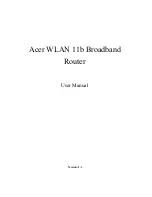
User’s Guide
Version 1.0
linkDown
A linkDown trap signifies that the SNMP entity, acting in an agent role, recognizes a failure in
one of the communication links represented in the agent's configuration.
linkUp
A linkUp trap signifies that the SNMP entity, acting in an agent role, recognizes that one of
the communication links represented in the agent's configuration has come up.
SNMP Agent
The SNMP agent responds to SNMP manager requests as follows:
Get a MIB variable – the SNMP agent begins this function in response to a request from the
SNMP manager. The agent retrieves the value of the requested MIB variable and responds to the
manager with that value.
Set a MIB variable – the SNMP agent begins this function in response to a message from the
SNMP manager. The SNMP agent changes the value of the MIB variable to the value requested
by the manager.
The SNMP agent also sends unsolicited trap messages to notify an SNMP manager that a significant
event has occurred (e.g. authentication failures) on the agent.
SNMP Community Strings
SNMP
community strings authenticate access to MIB objects and function as embedded passwords.
In order for the SNMP manager to access the controller, the community string must match one of the
two community string definitions on the controller. A community string can be as follows:
Read-only – gives read access to authorized management stations to all objects in the MIB
except the community strings, but does not allow write access.
Read-write – gives read and write access to authorized management stations to all objects in the
MIB, but does not allow access to the community strings.
Use SNMP to Access MIB
As shown in the picture
as below
SNMP agent gathers data from the MIB. The agent can send traps
(notification of certain events) to the SNMP manager, which receives and processes the traps. Traps
are messages alerting the SNMP manager to a condition on the network such as improper user
authentication, restarts, link status (up or down), MAC address tracking, and so forth. The SNMP
agent also responds to MIB-related queries sent by the SNMP manager in
get-request
,
get-next-
request
, and
set-request
format.
MIB
SNMP Agent
P-560
SNMP Manager
get-response, traps
get-request, get-next-reguest, get-bulk, set-request
+
figure 66 SNMP Management
BROWAN Page
55














































